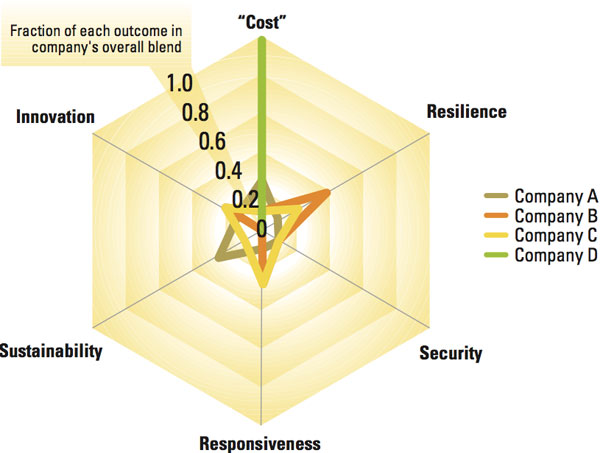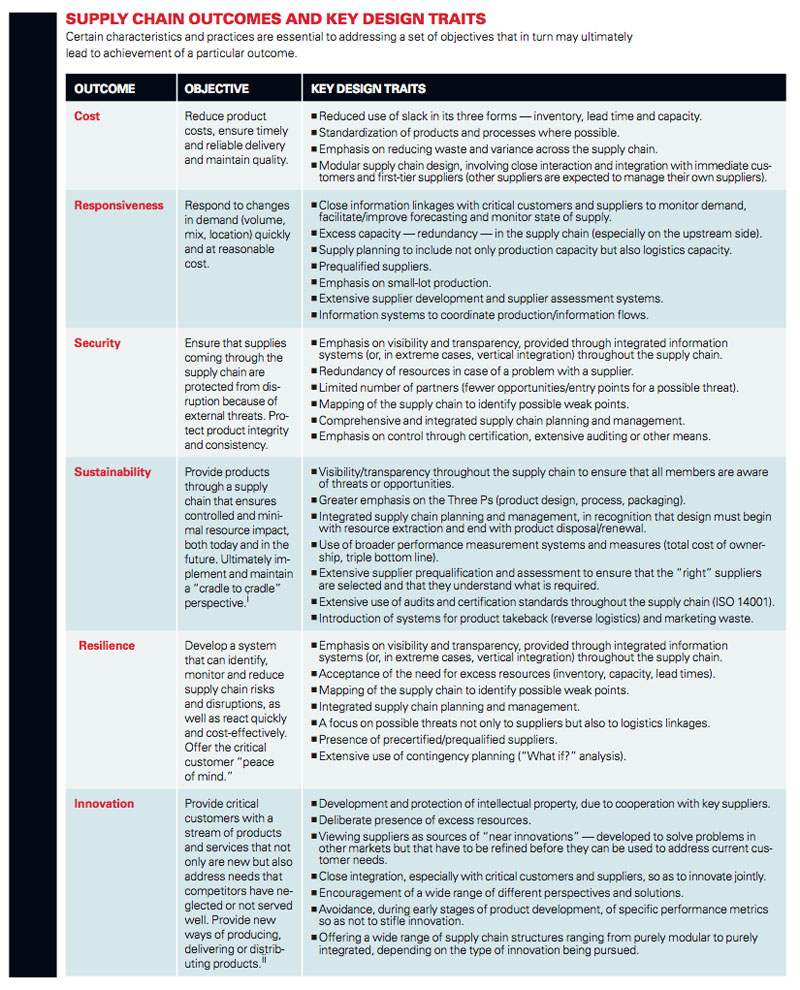Outcome-Driven Supply Chains
The supply chains of tomorrow must deliver varying degrees of six outcomes — the traditional cost-related benefit plus responsiveness, security, sustainability, resilience and innovation — depending on key customers’ needs.

Image courtesy of Wal-mart.
When properly designed and operated, the traditional supply chain has offered customers three primary benefits — reduced cost, faster delivery and improved quality. But managers are increasingly recognizing that these advantages, while necessary, are not always sufficient in the modern business world. A new paradigm is emerging of a more sophisticated supply chain — one that also serves as a vehicle for developing and sustaining competitive advantage under a variety of performance objectives.
The Leading Question
How can supply chains be designed and managed not only for reduced cost but also for multiple outcomes?
Findings
How can supply chains be designed and managed not only for reduced cost but also for multiple outcomes?
- There are six basic outcomes, each with a corresponding set of specific design traits.
- Outcomes should be blended, where feasible, without overfocusing on any single one.
- Supply chains’ design and management should be tailored to particular operating conditions.
In academic terms, we could say that while the old supply chain was strategically decoupled and price driven, the new supply chain is strategically coupled and value driven. More simply put, the supply chain should be designed and managed to deliver specific outcomes. So concluded participants in the Supply Chain Management 2010 and Beyond research initiative, a four-year set of surveys and workshops on which this article is based.
We believe that supply chains should provide one or more of six basic outcomes: “cost,” responsiveness, security, sustainability, resilience and innovation.
Cost. Reducing price (initially) and cost (ultimately) are the key objectives. This “cost” outcome is a combination of monetary cost (the primary performance criterion) and delivery and quality (secondary criteria). Using the terminology of Terry Hill,1 cost is the “order winner,” while delivery and quality are “qualifiers.”
Responsiveness is the ability to change quickly in terms of volume, mix or location as a function of changing conditions. Typically, responsiveness warrants a higher price.
Security is an outcome that has recently garnered a great deal of attention, with instances of tainted food products from China and tainted generic drugs from India. It implies that the supply chain’s products will not be contaminated or otherwise unsafe.
Sustainability differs from security, as it involves “green” — environmentally responsible — supply chains that eliminate waste, reduce pollution and contribute in a positive manner to improving the quality of the environment through eco-friendly processes, subassemblies and finished goods. Carbon footprint reduction along the supply chain is one example.
Resilience ensures that the supply chain can recover quickly and cost-effectively from disruptions caused by natural disasters (such as earthquakes), social factors (employee strikes), medical emergencies (epidemics such as H1N1 flu), economic setbacks (the bankruptcy of a critical link in the chain) or technological failures (a software crisis).
Innovation. In recent years, many companies have increasingly relied on their supply chains as a source of new products and processes or improvements in existing ones. Organizations’ key innovation tasks have been performed not only internally but also in collaboration with supply chain partners.2 For example, Lafley and Charan3 relate how Procter & Gamble Co. obtained new antiwrinkle technology from a small French cosmetics company, which led to P&G’s highly successful Olay Regenerist line of skin creams.
Once the desired outcome is selected, it influences critical supply chain characteristics and practices; some of these design traits are summarized in the table “Supply Chain Outcomes and Key Design Traits” (p. 37). But it is important to recognize that while the traits must be present somewhere in the supply chain, they need not manifest themselves in each and every link. Actually creating and harnessing these traits in the right places, however, is a major management undertaking, especially when the supply chain is comprised of more than one company.
For many managers new to supply chain management, this challenge is made more daunting by the lack of useful frameworks and guidelines, which are necessary if managers are to answer questions such as:
- How do you design a supply chain for a specific desired outcome?
- When can outcomes be blended, and under what conditions should they not be?
- How do you turn your supply chain into a competitive weapon?
We address these questions here.
Blending Supply Chain Outcomes
Some researchers and managers might be tempted to regard the six basic supply chain outcomes as mutually exclusive. But in practice, effective supply chains are often hybrids — reflecting various combinations of the six. Hau L. Lee4 in fact concluded from his extensive study that supply chains focusing on only one of the six outcomes were fatally flawed, as they could not develop and maintain a sustainable advantage over the competition. In particular, Lee found that supply chains offering low cost alone were unable to respond sufficiently to unexpected changes in demand and supply.
Blending Supply Chain Outcomes To Achieve Competitive Advantage

Similarly, the SCM 2010 and Beyond workshops indicated that such “overfocused” supply chains often cannot meet the requirements of the newly emerging business environment. In the figure “Blending Supply Chain Outcomes to Achieve Competitive Advantage,” for example, it appears that Company D is overfocused on cost. It will likely outperform any competitor as long as the customer demands the lowest price above all else. However, the other three companies are more adaptable and agile, as they offer a blend of outcomes.
The goal is to arrive at a blend that differentiates a supply chain from its competitors — a blend that key customers find attractive and for which they are willing to pay. Consider the following propositions about blending outcomes, supported by the current results of the SCM 2010 and Beyond project:
Blending outcomes means making trade-offs. When the supply chain manifests numerous outcomes, it is unlikely to outperform, on any single outcome, another supply chain that is more heavily focused on it. That is the price paid for having a supply chain that is adaptable, and it helps the company differentiate itself in the marketplace. On the other hand, a greater mix may position a supply chain for faster adaptation when market conditions change.
When blending outcomes, it is important for at least one of them to stand out. It might be tempting to try to build a supply chain that does a “decent” job on every outcome but fails to excel on any one of them. The problem with this approach is that the company may suffer from the curse of mediocrity, possibly rendering it a weak competitor.
Blending outcomes places greater emphasis on the alignment of incentives within the supply chain. The flexibility gained by blending allows greater responsiveness to the needs of critical customers, potentially resulting in a more competitive supply chain. But the incentives needed to ensure the appropriate actions and performance can vary substantially for different outcomes. Incentives for cost reduction, for example, may conflict with those for responsiveness and resilience.5
Blending outcomes complicates the performance measurement process. Dealing with only one outcome makes it easier to design a simple and mutually consistent set of metrics. When blending several outcomes, however, the measurement of performance becomes by necessity more complex — reductions in performance along one dimension might be necessary, for example, to allow performance improvements in other dimensions. It is also important to choose performance measures with care. If the goal is, say, to develop a supply chain that delivers responsiveness and sustainability, a focus on measuring and rewarding cost might create confusion and frustration.
Under certain conditions, blending outcomes allows for the leveraging of practices and resources. Some combinations of outcomes are complementary, as the practices and resources required to support a particular outcome may also serve other desired outcomes. For example, a cost-focused supply chain, with its emphasis on waste reduction and control, can more readily be transformed into a sustainable supply chain because many of the underlying tools and processes are the same. Similarly, the sharing of practices and resources is also possible when blending responsiveness and resilience. Responsiveness often demands buffers with respect to capacity, lead time and inventory, which also help increase resilience to supply chain disruptions.
The same or similar outcomes may be achieved by following different paths. Given the diverse ways in which different companies might achieve their supply chain objectives, there is no one monolithic approach to a set of supply chain outcomes. For instance, if one company wants to skim the price-insensitive segments of the market to recoup its cost of innovation, and another company favors a penetration strategy to gain large market share at a lower margin, the outcomes could be much the same. The differing approaches may be inevitable, even desirable, as each company should address its unique customer base in an optimal manner.
But while some outcomes can be blended effectively, other outcomes probably never should be. A primary example involves innovation and cost (especially if the latter outcome is pursued through the use of lean systems and other inventory-reducing practices). Here the procedures for attaining one outcome negatively affect the ability of the supply chain to attain the other outcome. Cost-oriented supply chains regard slack as a form of waste — something that must be eliminated or reduced. But innovation demands slack for success. Because failure is likely to occur during the innovation process, slack provides safety in the form of resources to complete the task without jeopardizing other aspects of the business.
Cost-driven supply chains also typically demand standardization of processes. In such systems, the mantra is often “Without standardization, there is no opportunity for improvement.” Yet for innovation truly to be successful, a diversity of processes and approaches is often needed.
Adaptability: Key to Success
By beginning with the outcomes and designing the supply chain to deliver them, the goal is not simply to align incentives or metrics. Rather, it is also to align the capabilities of the supply chain with the members’ shared vision for competitive success — based on a profound understanding of key customers. Full realization of this goal depends on a variety of factors, including the following:
Critical supply chain drivers. Companies such as Wal-Mart, Toyota and Dell have developed supply chains that are demand driven. But supply chains can also be supply driven, as when dealing in oil, gas, electricity and other products that cannot be stored for long periods of time. Supply chains can also be technology driven. What works well in one industry or context might not work in another.
Locations where the supply chain is deployed. Most of the academic work done in supply chain management has been limited to developed economies. Yet as companies focus more on low-cost-
country sourcing and other strategies that depend on emerging economies, many of the traditional assumptions regarding factors such as transportation, infrastructure, work force and security must be revisited.
Supply Chain Outcomes And Key Design Traits

Countries’ cultural differences. Business terms and practices that work well or are clearly understood in, say, North America can become sources of confusion or be totally misunderstood when applied in another setting. This point was driven home during the second 2010 and Beyond workshop, held in Lausanne, Switzerland, in June 2007. During the participant discussions the facilitators, who were from the United States, stressed the importance of collaboration. This term was bothersome to some of the European participants, however, who equated it, as a result of their history, with slavishly serving a hostile invader. Even when working with the British participants, the enduring truth of George Bernard Shaw’s classic observation — that the United States and England are two countries “separated by a common language” — became apparent.
Corporate cultures. A critical issue largely unaddressed in studies of supply chain management is that of corporate culture or, as one participant put it, “what people do when the boss is not around.” This issue helps shape how employees react in different situations and how they deal with changes. It influences what supply chain members see, with whom they interact and how they go about their daily routines. Such behaviors reflect companies’ core values, which need to be aligned if the supply chain is to succeed.
Stage of product life. The demands placed on the supply chain, as well as the kinds of product attributes viewed as acceptable by the customer, change as the product moves through various stages of evolution. For example, the outcomes of responsiveness, innovation and security may be critical during the introduction and early growth stages, but less so as the product matures and concerns for cost and resilience become dominant. We would expect supply chain design and capability to adapt to these changing factors.
Our goal here has been to demonstrate that one size does not fit all and that future supply chains must first and foremost be tailored to the end-user. In today’s world, it is typical that low cost can readily be replicated and thus is unlikely to lead to competitive advantage over the long term. Supply chain managers will succeed only if they understand the needs of key customers and strive to maintain alignment between the supply chain’s design and its customers’ changing needs and desires. To paraphrase Charles Darwin, it is not the strongest that survives, it is the most adaptable to change.
References (7)
1. T. Hill, “Manufacturing Strategy: Text and Cases,” 3rd ed. (McGraw Hill Higher Education, 2000).
2. D. Tapscott and A. Williams, “Wikinomics: How Mass Collaboration Changes Everything” (New York: Penguin Group USA, 2008).





Comment (1)
jconnor